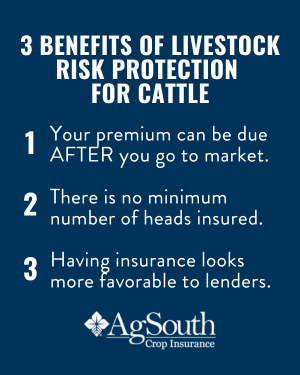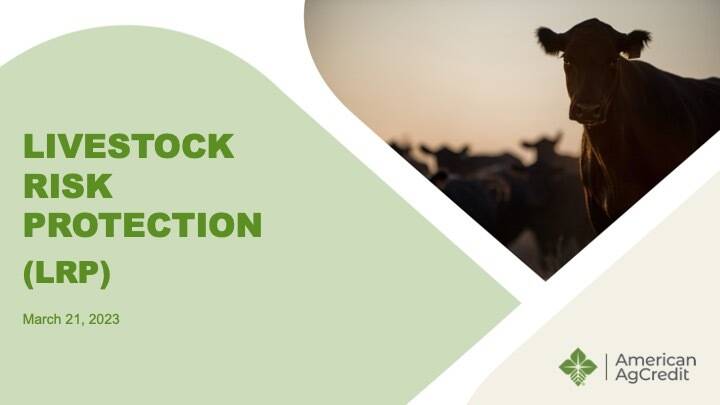Key Factors to Take Into Consideration When Picking Animals Risk Security (LRP) Insurance
When assessing options for Livestock Risk Security (LRP) insurance policy, several vital variables call for careful factor to consider to ensure efficient risk management in the agricultural sector. Choosing the best protection options customized to your specific animals procedure is critical, as is recognizing just how superior expenses correlate with the level of defense provided.
Insurance Coverage Options
When thinking about Livestock Threat Protection (LRP) insurance policy, it is vital to comprehend the different protection alternatives available to mitigate threats in the agricultural market. Livestock Threat Protection (LRP) insurance coverage offers different protection choices tailored to meet the varied demands of animals producers. Bagley Risk Management. One of the primary coverage choices is price coverage, which secures against a decline in market value. Producers can pick the protection level that aligns with their price risk monitoring objectives, permitting them to safeguard their procedures against prospective financial losses.
Another essential insurance coverage choice is the recommendation duration, which figures out the size of time the insurance coverage holds. Producers can choose the endorsement duration that best matches their production cycle and market problems. In addition, insurance coverage levels and rates vary based on the sort of livestock being insured, providing manufacturers the versatility to customize their insurance policy plans according to their details requirements.
Comprehending the various insurance coverage alternatives offered under Livestock Risk Defense (LRP) insurance coverage is critical for producers to make educated choices that successfully protect their animals procedures from market uncertainties.
Costs Expenses

Animals Danger Protection (LRP) insurance policy provides vital coverage options customized to alleviate risks in the farming sector, with a significant facet to take into consideration being the estimation and framework of premium costs. When establishing premium prices for LRP insurance, several variables enter play. These consist of the type and variety of livestock being guaranteed, the coverage degree selected, the current market rates, historical price information, and the length of the coverage duration. Insurance firms may additionally consider the location of the farm, as geographical elements can impact the overall risk profile.
Insurers evaluate historic data on animals rates and manufacturing expenses to identify a suitable costs that shows the degree of risk involved. It is crucial for livestock manufacturers to thoroughly evaluate premium expenses and protection options to ensure they are sufficiently protected against prospective monetary losses due to damaging market conditions or unexpected events.
Eligible Livestock
The resolution of qualified animals for Livestock Danger Defense (LRP) insurance coverage includes cautious consideration of details requirements and qualities. Livestock kinds that are generally qualified for LRP insurance include feeder cattle, fed livestock, swine, and lambs.
Feeder livestock, as an example, are typically eligible for LRP insurance coverage if they fall within specified weight arrays. Fed cattle might also be qualified, but they must satisfy certain weight and top quality grade needs. Swine eligible for coverage generally consist of market weight pets intended for slaughter. Lambs are another group of animals that can be taken into consideration for LRP insurance coverage, with aspects such as weight and age playing an important duty in establishing their eligibility.
Before picking LRP insurance policy for livestock, producers must carefully examine the eligibility standards laid out by the insurance provider to guarantee their pets fulfill the required demands for insurance coverage.
Plan Flexibility
Plan adaptability click this link in Animals Threat Protection (LRP) insurance enables manufacturers to customize protection to fit their details needs and run the risk of administration techniques. This flexibility equips animals producers to personalize their insurance policies based upon aspects such as the kind of livestock they have, market conditions, and private risk resistance degrees. One vital facet of policy flexibility in LRP insurance coverage is the ability to pick protection levels that align with the manufacturer's financial goals and take the chance of direct exposure. Manufacturers can pick protection levels that secure them versus prospective losses as a result of variations in animals prices, guaranteeing they are adequately guaranteed without overpaying for unneeded insurance coverage. Additionally, LRP insurance provides versatility in plan period, permitting producers to select coverage periods that finest fit their production cycles and advertising and marketing timelines. By offering customizable choices, LRP insurance coverage enables manufacturers to successfully handle their risk exposure while protecting their livestock procedures against unexpected market volatility.
Insurance Claims Process
Upon experiencing a loss or damages, manufacturers can launch the insurance claims procedure for their Animals Threat Defense (LRP) insurance by quickly calling their insurance service provider. It is crucial for producers to report the loss asap to accelerate the insurance claims process. When reaching out to the insurance policy company, manufacturers will need to supply thorough information concerning the occurrence, consisting of the click here for more info date, nature of the loss, and any kind of appropriate documents such as veterinary documents or market value.

After the evaluation is full, the insurance policy copyright will certainly choose pertaining to the case and interact the outcome to the producer. The manufacturer will get compensation according to the terms of their Animals Threat Security (LRP) insurance coverage plan if the insurance claim is authorized. It is vital for producers to be accustomed to the cases process to navigate to this website guarantee a smooth experience in case of a loss

Conclusion
In verdict, when selecting Animals Threat Security (LRP) insurance policy, it is vital to consider protection alternatives, premium prices, eligible livestock, plan flexibility, and the cases process. These key elements will certainly help guarantee that ranchers and farmers are appropriately protected against possible threats and losses related to their animals operations. Making an informed decision based upon these factors to consider can eventually lead to much better monetary safety and security and comfort for animals producers.
Livestock Risk Defense (LRP) insurance policy supplies different protection choices customized to satisfy the varied requirements of animals manufacturers.The decision of eligible animals for Animals Threat Protection (LRP) insurance coverage entails mindful factor to consider of details requirements and characteristics.Policy adaptability in Livestock Danger Security (LRP) insurance allows producers to customize protection to suit their particular demands and run the risk of management approaches.Upon experiencing a loss or damage, manufacturers can start the claims process for their Livestock Risk Security (LRP) insurance policy by promptly calling their insurance policy supplier.In final thought, when picking Livestock Danger Protection (LRP) insurance coverage, it is vital to think about insurance coverage options, premium expenses, qualified animals, policy flexibility, and the insurance claims procedure.